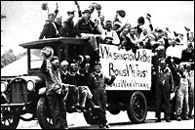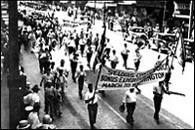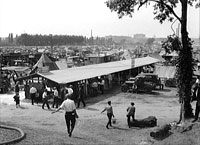|
History of the Department of Veterans Affairs - Part 3
View or download in PDF format (136 KB PDF)
The Bonus March
 World War I Veterans Descend on Washington, DC World War I Veterans Descend on Washington, DC |
|
The Great Depression was merciless. The loss of jobs, life savings and confidence left many unable to make a living. Trapped in its wake, World War I veterans suffered tremendous pressure during the economic slump. After returning from the Great War, many faced destitution and did all they could to survive.
On May 19, 1924, Congress intervened by passing the World War Adjustment Compensation Act. The act provided a bonus to World War I veterans based on
|
the length and location of their service: one dollar per day served in the United States and one dollar and a quarter per day served overseas. The payments were intended to bring about economic balance between the veterans -- who generally received low wages in the service -- and those who stayed home and benefited from wartime industry.
But there was a catch. Veterans who were authorized bonuses of more than $50 were issued adjusted service certificates from the Veterans' Bureau. These certificates were a form of an endowment policy payable 20 years from the date of issue and generally had a face value of $1,500.
|
| |
|
|
| As the Depression worsened, veterans began calling for immediate payment of their “bonuses,” as the certificates came to be called. In March 1932, a small group of veterans from Oregon began marching to Washington, D.C., to demand payment. Word of the march spread like wildfire and soon small bands of unemployed veterans from across the country began descending on the nation's capital. |
|
 World War I Bonus Marchers World War I Bonus Marchers |
There is no way of knowing how many veterans joined the “Bonus Expeditionary Forces,” as the marchers were called. By the summer, some estimates put the force at between 15,000 and 40,000. They camped wherever they could. Some slept in abandoned buildings or erected tents. But many lived in makeshift shacks along the mudflats of the Anacostia River. With no sanitation facilities, living conditions quickly deteriorated in the “shanty town.”
|
|

Bonus Marchers' Encampment
|
|
Health officials grew concerned about the threat of disease. In response, the newly created Veterans Administration established an emergency hospital on a War Department reservation at Fort Hunt, Va., on June 11, 1932. The hospital treated 282 veterans that summer, many for diarrhea, dysentery and influenza.
On June 17, a large group of marchers laid an orderly siege to the U.S. Capitol, where the Senate was considering a bill proposing immediate payment of the bonuses. Despite the veterans' attempts to drum up
|
support for the bill, it was overwhelmingly defeated. Frustrations mounted as the summer wore on.
On July 28, a riot erupted when city police officers and agents from the U.S. Treasury Department tried to evict some of the marchers. As the situation spiraled out of control, the District of Columbia asked President Herbert Hoover to send federal troops to help restore order. The request noted that it was “impossible for the Police Department to maintain law and order except by the use of firearms, which will make the situation a dangerous one.”
|
President Hoover knew he had to curb the escalating violence. He gave the order for Army Chief of Staff Gen. Douglas MacArthur to forcibly remove from the city the approximately 3,500 veterans, many with their wives and children, who refused to leave. No shots were fired, but many were injured by bricks, clubs and bayonets. Although there are conflicting reports on which side started the fires, some of the marchers' shacks burned down. In the end, the presence of federal troops effectively ended the bonus march.
|
Bonus Marchers at the U.S. Capitol |
Congress authorized VA to pay transportation expenses for marchers to return to their homes plus a daily subsistence allowance of 75 cents. According to a 1932 annual report, VA paid transportation costs for 5,160 veterans totaling $76,712.02.
Though the marchers failed to get immediate results, in 1936 Congress authorized early payment of the bonuses. By June 30, 1937, VA had certified as payable nearly 3.5 million applications from World War I veterans for settlement of their certificates.
At first glance, the bonus march seems like the public relations debacle of the decade. It revealed serious shortcomings in how America cared for her defenders as they transitioned from military to civilian life. But without the march, these shortcomings may never have been known. And the key is not whether shortcomings existed, but how they were addressed.
Congress addressed the problem by passing what many have called one of the most significant pieces of legislation ever produced by the federal government — the GI Bill of Rights, a comprehensive benefits package to aid the transition of 16 million veterans returning from World War II.
End of Part 3
VA operates hundreds of medical facilities, issues millions of checks for education, disability and pensions, and supervises more than 125 national cemeteries. With more than 275,000 employees (as of September 2008), VA is America's second largest federal agency. When eligible dependents and survivors are included, approximately 63 million people -- about one-quarter of the nation's population -- are eligible for VA benefits and services.
|
Return to History of the VA Home Page.
PDF Documents - To read PDF documents, you need a PDF viewer. Links to viewer software can be found here.
|


